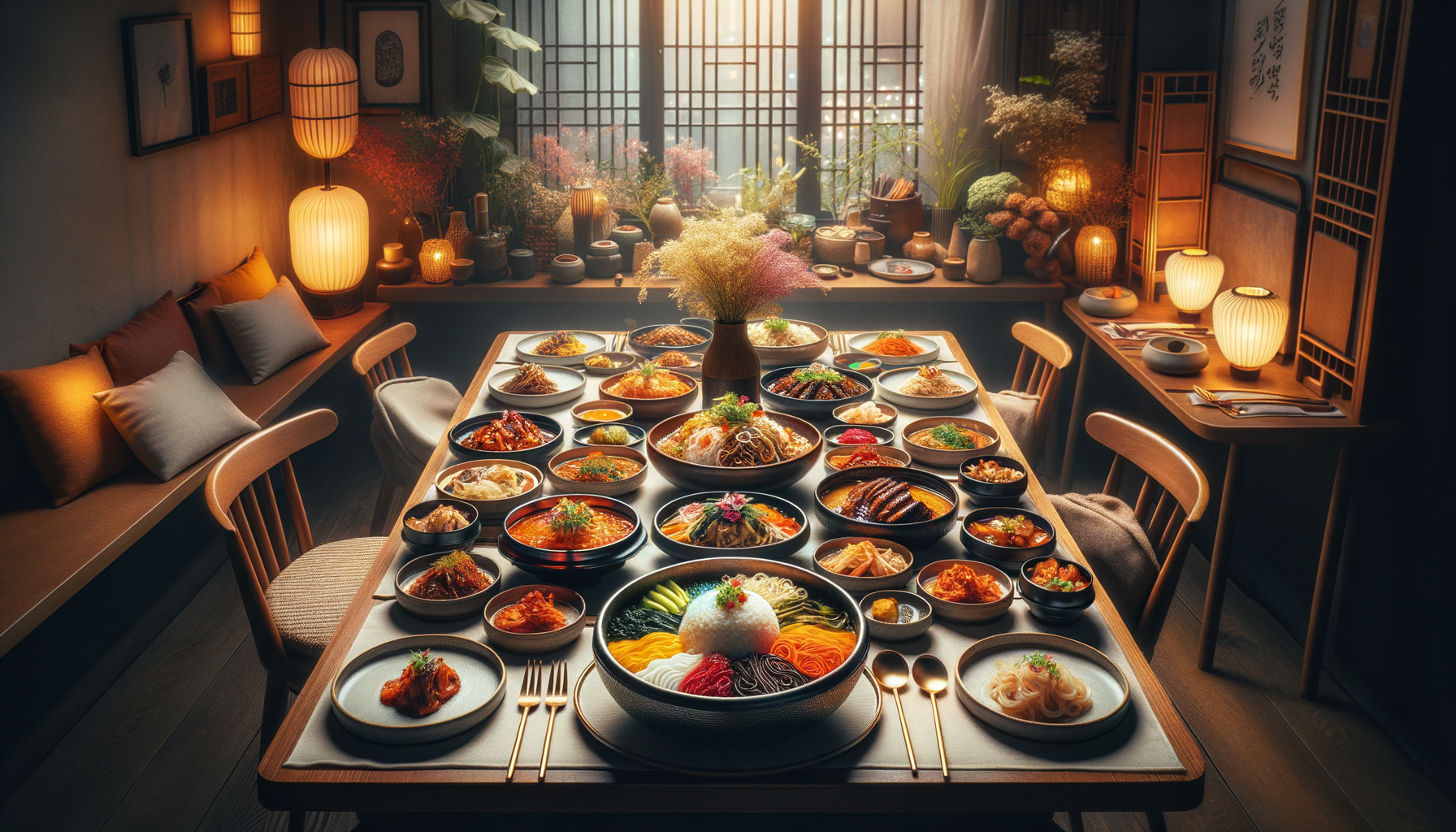
안녕하세요?
English: Hello.
메뉴판 주세요.
English: May I have the menu, please?
주문 도와주실래요?
English: Could you help me place an order?
이거 추천해 주세요.
English: Please recommend this.
제일 인기 있는 메뉴가 뭐예요?
English: What’s the most popular menu item?
이것은 무엇인가요?
English: What is this?
매운 거 잘 못 먹어요.
English: I can’t handle spicy food well.
매운 거 좋아해요.
English: I like spicy food.
얼마예요?
English: How much is it?
이걸로 주문할게요.
English: I’ll order this.
물 좀 더 주실 수 있어요?
English: Could I have some more water?
밥 추가해 주세요.
English: Please add more rice.
김치 좀 더 주실 수 있나요?
English: Could I have some more kimchi?
이 음식은 어떻게 먹나요?
English: How do I eat this dish?
시간이 얼마나 걸려요?
English: How long does it take?
포장 가능한가요?
English: Can I get it to go?
계산서 주세요.
English: The check, please.
카드로 결제할 수 있나요?
English: Can I pay by card?
현금으로 낼게요.
English: I’ll pay in cash.
영수증 주세요.
English: Please give me the receipt.
음식이 너무 맛있어요!
English: The food is so delicious!
잘 먹었습니다.
English: Thank you for the meal. (I ate well.)
여기 정말 좋아요.
English: I really like this place.
다음에 또 올게요.
English: I’ll come again next time.
서비스로 주시는 건가요?
English: Is this on the house?
이 음식에는 무슨 재료가 들어가나요?
English: What ingredients are in this dish?
조금만 맵게 해주세요.
English: Please make it only a little spicy.
아주 맵게 해주세요.
English: Please make it very spicy.
숟가락하고 젓가락 주세요.
English: Please give me a spoon and chopsticks.
잔치국수 주문할게요.
English: I’ll have the banquet noodles.
불고기 한 접시 주세요.
English: Please give me one plate of bulgogi.
비빔밥 하나 주세요.
English: I’d like one bibimbap.
갈비탕 하나 주세요.
English: One galbitang, please.
김밥 두 줄 주세요.
English: Two rolls of gimbap, please.
된장찌개 한 그릇 주세요.
English: One bowl of doenjang stew, please.
소주 한 병 주세요.
English: One bottle of soju, please.
맥주 두 병 주세요.
English: Two bottles of beer, please.
음료수 뭐가 있나요?
English: What beverages do you have?
무료 리필 되나요?
English: Do you offer free refills?
이것 좀 가져다주세요.
English: Could you bring me this, please?
추가로 밥 좀 더 주세요.
English: Could I have some extra rice?
양념장 좀 더 주세요.
English: Please give me more sauce.
물 만나주실래요?
English: Could I get some water?
여기 청결해요.
English: It’s clean here.
좌석이 더 있나요?
English: Are there any more seats available?
예약했습니다.
English: I made a reservation.
창가 자리 있나요?
English: Is there a window seat?
화장실 어디예요?
English: Where is the restroom?
주차장은 어디 있나요?
English: Where is the parking lot?
테이크아웃용으로 준비해주세요.
English: Please prepare it for takeout.
Have you ever walked into a Korean restaurant, glanced at the menu, and felt a little overwhelmed? Don’t worry—everyone has been there at some point. Korean cuisine is brimming with vibrant flavors, communal dining customs, and delightful discoveries just waiting to be tasted. It’s okay to feel unsure, especially if you’re new to this culinary world. In fact, those small moments of uncertainty can make the experience even more memorable!
Exploring the Richness of Korean Cuisine
Korean food is often described as a zesty combination of sweet, spicy, salty, and tangy flavors. From fermented delights to shiny bowls of steaming rice, it has a distinct identity that entices food lovers around the globe. Below are some of the most beloved dishes you might find:
Bibimbap (비빔밥)
Kimchi (김치)
Bulgogi (불고기)
Samgyeopsal (삼겹살)
Japchae (잡채)
These special meals frequently come with side dishes called banchan (반찬), such as underlined kimchi (김치) and other pickled or marinated vegetables. In many Korean households, mealtime is not complete without at least a few of these tasty extras.
Common Korean Phrases for Ordering
Feeling brave enough to practice some Korean phrases at your next restaurant visit? Start with these:
이거 뭐예요? (igeo mwoyeyo?)
“What is this?” Use it to ask about a mysterious dish that catches your eye.
이거 주세요. (igeo juseyo.)
“Please give me this.” Polite and straightforward—perfect for pointing at menu items.
맵지 않게 해주세요. (maepji anke haejuseyo.)
“Please make it not spicy.” Ideal if you want to enjoy your meal without too much heat.
물 좀 주세요. (mul jom juseyo.)
“Can I have some water?” Essential for staying hydrated, especially if you’re eating spicy dishes!
계산서 주세요. (gyesanseo juseyo.)
“Check, please.” A handy phrase for wrapping up your dining experience.
A Handy Numbered Cheat Sheet
Let’s break down a few more practical expressions step by step:
알레르기 있어요. (allereugi isseoyo.)
I have an allergy. 2. 이 음식에 뭐가 들어갔어요? (i eumsige mwoga deureogasseoyo?) What’s in this dish? 3. 더 주세요. (deo juseyo.) More, please. 4. 덜 맵게 해주세요. (deol maepge haejuseyo.) Make it less spicy, please. 5. 저는 채식주의자예요. (jeoneun chaesikjuuijayeyo.) I’m vegetarian.
When trying these out, remember that a friendly smile can help you feel more comfortable—even if you stumble a bit over pronunciation.
Tip: Underlined gochujang (고추장) is a signature red pepper paste often added to many dishes. If you see it on the table, feel free to give it a go. Just be prepared—it can be spicy!
Tip: Some restaurants serve large portions meant for sharing. Don’t hesitate to order a few plates and split them with your friends or family.
Tip: If you see bap (밥) on the menu, that usually means “rice.” Pair it with soup (국, guk) or stew (찌개, jjigae) for a real taste of home-style Korean comfort.
The Heart of Korean Food Culture
One of the most fascinating parts of Korean dining is the communal aspect. People often share dishes, pass side plates around, and enjoy the conversation as much as the meal itself. By coming together at the dinner table, friends, family, and even strangers bond over bite-sized parcels of grilled meat or sizzling hot stone bowls of rice.
It’s polite to say 잘 먹겠습니다 (jal meokkesseumnida) before you start eating.
After you’re done, you can say 잘 먹었습니다 (jal meogeosseumnida) to express gratitude.
These customs reflect respect, underlined hospitality, and the joy that surrounds every Korean dining experience.
Final Thoughts
Korean cuisine is about more than just satisfying your hunger; it’s a celebration of flavors, seasonality, and togetherness. Sure, you might run into a few hiccups when ordering in Korean, but those minor mistakes and playful exchanges often lead to moments of real connection. Embrace the bold tastes, share plates with your companions, and don’t forget to try something new each time you dine out.
Enjoy your meal (맛있게 드세요, masitge deuseyo!) and savor the adventure. With every spoonful of soup or piece of kimchi, you’re taking part in a centuries-old tradition that continues to delight and bring people closer—one table at a time.
References - Cho, J. (2015). Korean Cuisine: A Cultural Journey. Seoul: Hollym International Corp. - Joo, H. (2020). Korean Home Cooking: Classic and Modern Recipes. New York: Clarkson Potter Publishers. - Kim, S., & Chun, J. (2012). The Korean Table: From Barbecue to Bibimbap. North Clarendon: Tuttle Publishing. - Lee, H. J., Chung, K. R., Yang, I. S., Cha, J. A., & Chung, L. (2010). Objective properties of Korean traditional soy sauce and commercial soy sauce. Korean Journal of Food Preservation, 17(1), 29-35. - Yoon, S. S., & Chung, K. R. (2017). Fermented Foods of Korea. Berlin: Springer Singapore.
